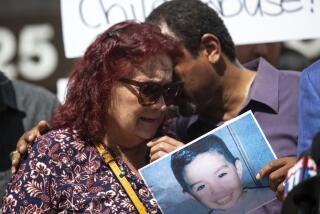Valley Parenting : Learning Lifesaving at Home : Families and baby-sitters can get first aid training in the comfort of their own living rooms.
- Share via
Imagine the worst. Your infant has stopped breathing or your child begins to choke, and there you are, scrambling to remember techniques you learned in a long-ago first aid class.
While no parent wants to visualize a life-or-death emergency involving a child, the popularity of cardiopulmonary resuscitation (CPR) courses attests to the desire of many to be prepared. Often, the birth of a child is the impetus for a family to learn CPR, but new parents may find it difficult to leave the house for a class.
The alternative--having a certified instructor come to you--is fast becoming popular, not only for families but also for baby-sitters and friends who share child-care responsibilities.
Private living rooms are the stage for these three- to four-hour classes, in which instructors cover everything from accident prevention to life-saving breathing and chest-compressing techniques, using child- and adult-sized mannequins to demonstrate.
Home classes are scheduled at a client’s convenience--often on Saturday morning or in the evening.
“Sometimes people include the CPR class as the main activity of a baby shower, or have a pizza brought in and invite friends, neighbors and nannies--anyone who wants to be trained in CPR,” says Fern Carness, who teaches home sessions for Wellness at Work Inc. in Granada Hills.
Despite the fun of these events, their overall goal, says Carness, is seldom lost on participants. Ideally, students wind up with a new confidence based on knowledge--a confidence that may enable them one day to save a life.
This is especially critical for parents, who might be prone to panic at the sight of a choking child. And as these courses make clear, there are differences in the way CPR is administered, depending on whether the victim is an infant, child or adult.
According to instructors, parents are often less anxious and more receptive to learning in an informal, personal setting than they are in hospital or community center classrooms. But whatever the setting, the event can be stressful for some, as it was for Pat LoPresti, a mother who organized a class at a friend’s Northridge home.
*
“I was extremely nervous when I went to work on the dolls; I was very emotional, imagining the doll was one of my kids,” says LoPresti.
Confronting the basics of CPR can also cause anxiety for families who take a class in the wake of a friend’s heart attack or a neighborhood emergency, says Sheree Jones-Pistol, an independent CPR instructor. These participants realize, perhaps more dramatically than others, that their skill--or lack of it--could play a role in someone’s chances for survival.
Fear of not being able to act effectively in an emergency keeps some people from taking a CPR class at all, says Glen Kouvacs, director of HEALTHWATCH, a Woodland Hills health education firm. “The normal reaction to a cardiac or respiratory emergency is to walk the other way.”
It takes training, Kouvacs explains, to jump into a crisis situation and do something. “People are typically afraid they will do something wrong and don’t realize that anything--any breathing or compression--is better than doing nothing,” he says.
In contrast to CPR classes of the past, those taught now are designed to be as comfortable and unintimidating as possible. CPR classes used to be presented on a pass/fail basis and weren’t “user-friendly,” Kouvacs explains. “We’ve made people scared to do CPR and afraid that if they don’t do each step perfectly, they’re unqualified.”
A new, more relaxed approach--approved by both the American Heart Assn. and the American Red Cross--eliminates written tests and stresses that the object is not passing a course but learning to do something effective in a crisis.
Most home classes cover both infant and child CPR, along with the basics of dealing with a choking child. In an additional hour, instructors will also review adult CPR if the participants wish. The cost varies but is generally about $25 a person, with a minimum of six to ten students per class.
Instructors, who should be certified by the Red Cross or American Heart Assn. in basic life support, may be nurses, firefighters or lay people with special training. Classes include both discussion and actual practice, and provide easy-to-review written material for further reference.
Because CPR is a use-it-or-lose-it skill, instructors suggest that parents go over the basics again periodically. Many video stores offer no-cost rentals of CPR videos, a review tool teachers recommend.
More to Read
Sign up for Essential California
The most important California stories and recommendations in your inbox every morning.
You may occasionally receive promotional content from the Los Angeles Times.













